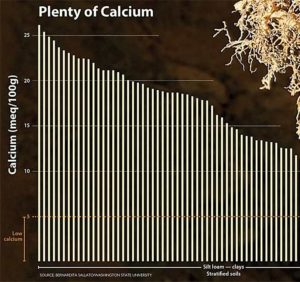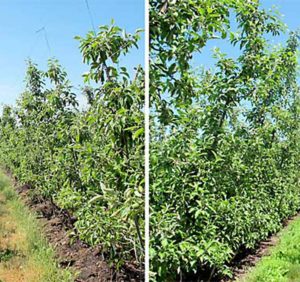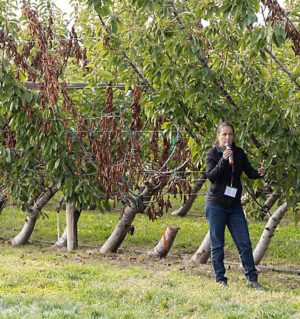Growers gathered in person and online for three days of educational presentations and panel discussions at this year’s North Central Washington Tree Fruit Days Jan. 18–20.
The event, sponsored by Washington State University Extension, the North Central Washington Fieldmen’s Association, Northwest Cherries, Pear Bureau Northwest and the Okanogan Horticultural Association, featured one day of talks each for apple, cherry and pear.
Apple day started with a focus on codling moth control. WSU entomologist Betsy Beers shared updates from a recent industry survey about challenges with controlling the pest, and a panel of crop consultants shared insights.
The panelists, Justin Wiggs from Chamberlin Agriculture, Chuck Weaver from G.S. Long Co., and Mike Doerr from Wilbur-Ellis, warned growers to keep an eye out for sources of codling moth, such as abandoned orchards, backyard trees and bin piles.
Wiggs said that with organic materials, those outside sources can turn into a really big problem really quickly.
“A lot of these materials that work in organics work best in the first generation. You really have to come out swinging,” he said. “You could get it really clean, but if you have … summer pressure from a backyard tree nearby, organically, it’s going to be a challenge.”
Wiggs and Weaver also warned growers that virus degrades quickly under high ultraviolet light and heat, so at different times it might not offer as much protection as people expect.
Doerr stressed the importance of oil applications for organic producers.
“Oil reduces populations by 50 percent. That’s what sets up pheromones and virus and Entrust to be successful,” he said. “You need to have 100 gallons per acre with 1 percent oil every two weeks on high-pressure organic blocks.”
Turning to horticulture, Bernardita Sallato from WSU Extension shared insights from her experience and research managing bitter pit in apples. While low calcium levels in the fruit cause the disorder, it’s not always traced back to a lack of supply in the soil. She suggested looking a potassium levels, because high potassium is common in Washington and can outcompete calcium uptake, and also looking at building healthy root systems to drive uptake.
“We need the calcium in the early season for the cell walls,” she said. “The most efficient way for the plant to take up that calcium is through the root system to the fruit. Adding foliar calcium is more of a temporary solution when you have problems in the root zone.”
Tianna DuPont, also of WSU Extension, shared findings from a project looking at how soil health indicators can improve orchard planting decisions. By pairing orchard sites with similar plantings and regions — but different performance — and looking at a wide variety of soil indicators, she was able to find where factors such as plant parasitic nematode pressure, water-holding capacity or soil compaction were limiting production.
Finding these limiting factors will help growers know how to evaluate soil health and take mitigation steps, such as ripping to reduce compaction and fumigation or cover cropping to reduce nematode pressure, before planting.
On stone fruit day, WSU scientists shared little cherry disease research and management updates, spotted wing drosophila research updates and management advice on bacterial canker and powdery mildew, while Northwest Cherry Growers president B.J. Thurlby shared his outlook on the cherry market.
—by Kate Prengaman









Leave A Comment